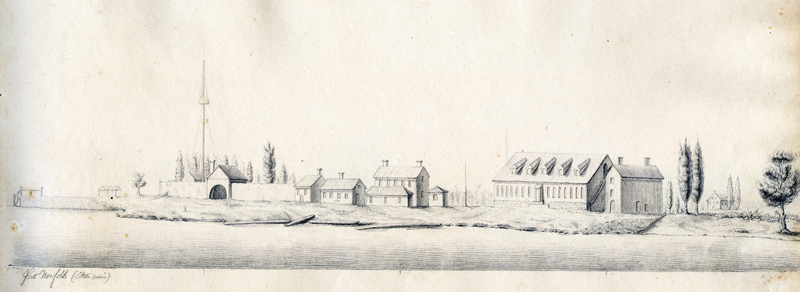
Fort Norfolk History - 1820-1821
Fort Norfolk's physical condition deteriorated during the period 1817-1824. Despite Captain Lomax's apparent efforts to the contrary, the War Department had resolved to spend as little as possible at Fort Norfolk. In 1820, Lomax requested funds for the repair of "the piazza in front of the officer's quarters." After several months had passed, Lieutenant Edward Brimhall, the post quartermaster wrote to Washington stating that the damage was the result of "natural decay" and requested $120 to undertake the work (Officer of the Quartermaster General [OQMG] Brimhall to Jessup, June 24, 1820). It is not known if the repairs were ever made.

In late 1820, Colonel Charles Gratiot of the U.S. Army Corps of Engineers arrived at Norfolk to conduct an inspection of the two harbor forts. He recorded a brief architectural description of Fort Norfolk. "The parapets and ramparts are reveted with brick," Gratiot noted, "the other part of the two sides, not included in the circular work are broken, the one into a Bastion, the other into a salient." In back of the ramparts, the fort was defended "by a range of strong barracks with loop holes for musketry." Gratiot also documented the decline of the fort. He described the "elevated battery of about 30 heavy cannon" as being in a "weak condition." The platforms and gun carriages he found "ruinous" and the "abutments and angles [were] decaying by the operation of the weather" (ROCE, Land Papers).
Gratiot did not mention the condition of the buildings at Fort Norfolk, but they too were apparently suffering from neglect. To make matters worse, a severe storm on September 3, 1821, inflicted "considerable injury at the two posts in the harbour, particularly the buildings." According to Lieutenant George Corprew, the Norfolk harbor quartermaster, the most seriously damaged building was "the quarters intended for the commanding officer of this harbor." It is not certain that the building Corprew described and the "officers' quarters" at Fort Norfolk are the same. According to Corprew, the storm had blown both chimneys over and sent them crashing through the roof of the unoccupied commanding officers’ quarters. The falling chimneys had crushed "both sides” of the building and had done "considerable damage to the interior." Corprew reported that a new commanding officer, Colonel Lindsay, was "expected daily" and that he would have to rent quarters in the town for accommodation (OQMG Corprew to Jessup, November 4, 1821).
More History
Back, 1673, 1775, 1787, 1789, Army before 1793, 1793, 1794, More 1794, First Fort, 1795, 1796-1800, 1801-1806, 1807, 1808-1811, 1812, 1813, 1813-1814, 1816, 1817-1818, 1820-1821, 1824, 1835, 1842-1844, 1845, 1849, 1851, 1852, 1853, 1854, 1854 Keeper's House, 1854 Changes, 1858, 1859, 1861, 1862, 1863, 1864, 1875, 1884, 1893, 1903, 1923, Next
Source of Information
A CULTURAL RESOURCE MANAGEMENT PLAN OF FORT NORFOLK, NORFOLK, VIRGINIA prepared for U.S. Army Corps of Engineers, Norfolk District by the College Of WILLIAM & MARY, November 1995 under Contract No. DACW65-94-Q-0075.
David A. Clary's Fortress America: The Corps of Engineers, Hampton Roads, and United States Coastal Defense (1990)
William Bradshaw and Julian Tompkins's Fort Norfolk, Then and Now (n.d.).
The Norfolk Public Library vertical file of recent newspaper articles on Fort Norfolk. Including articles by James Melchor of the U.S. Army Corps of Engineers that describe archaeological and architectural findings on the fort property.
